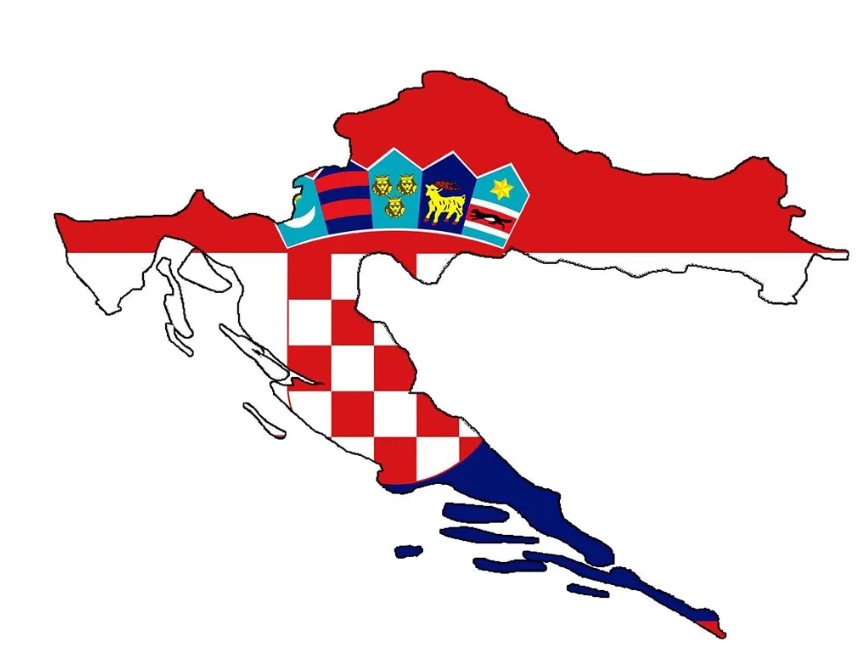
Croatia is a smallish crescent-shaped country of 4.2 million people, located in the northwestern part of the Balkan Peninsula.
Its capital is Zagreb.
The Croatian crescent is bordered by Serbia (east), Hungary and Slovenia (north), Montenegro (south) with the hollow section bordering Bosnia and Herzegovina. There are over 1200 islands as part of Croatia and over 10% of the nation is protected as national parks.
For Game of Thrones fans, there really is no destination that compares to Croatia. Croatia became the home of King’s Landing but other Croatian coastal towns and villages became Westeros. It is the home of many of the filming locations especially within and around the towns of Dubrovnik and Split.
Some key locations and areas include:
- Trogir: used as the city of Quarth
- Kastel Gomilica was the Braavos fisherman’s village where Arya Stark was selling her oysters.
- Klis Fortress: was the town of Meereen where Daenerys executed slave owners
- Žrnovnica: the bathing scene of Missandei and Gray Worm in the beautiful watermill.
- Šibenik – the city of Iron Bank in Braavos
- Diocletian’s palace (Split)
- cellars- where Daenerys kept and trained her dragons
- alleys – were scenes of Meereen slave revenge and the corridor where the Sons of the Harpy waited for the Unsullied.
- Dubrovnik
- Trsteno Arboretum – the gardens of Kings Landing
- Minceta Tower – house of the undying
- Lovrijenac Fortress – the tournament to honour King Joffrey’s name
- Lokrum Island – where Khaleesi meets the Spice King
- Bokar Fortress – Kings Landing
- Gradac Park – where King Joffrey finally met his demise
- St Dominika Street – wherre Queen Cersei was forced to walk through the town naked as a sign of penance.
- Poljana Ruder Boskovica Street – where Sansa ran away during the riot
- Hotel Belvedere – battle between Prince Oberyn Martell and Gregor Clegane
- Jesuits Staircase – Steps of the Great Sept of Baelor
- Fort Lovrijenac – the Red Keep
- West Pier – Blackwater Bay
- Pile – Kings Landing harbour
The original Iron Throne was gifted by HBO to the city of Dubrovnik, and today you can find it inside the Visitors Centre on Lokrum Island. Apart from the tours, Split also built a Game of Thrones museum that bought a lot of props from the show and displayed them for you to enjoy but the museum visit is usually not included in the tour since it’s best enjoyed when visiting alone.
Zagreb
Zagreb is the cultural, scientific, economic, political and administrative centre of the Republic of Croatia. Zagreb (with a population of just over 800,000), contains almost a quarter of the entire Croatian population. Over the centuries, the city has been inhabited by people from all over Europe.
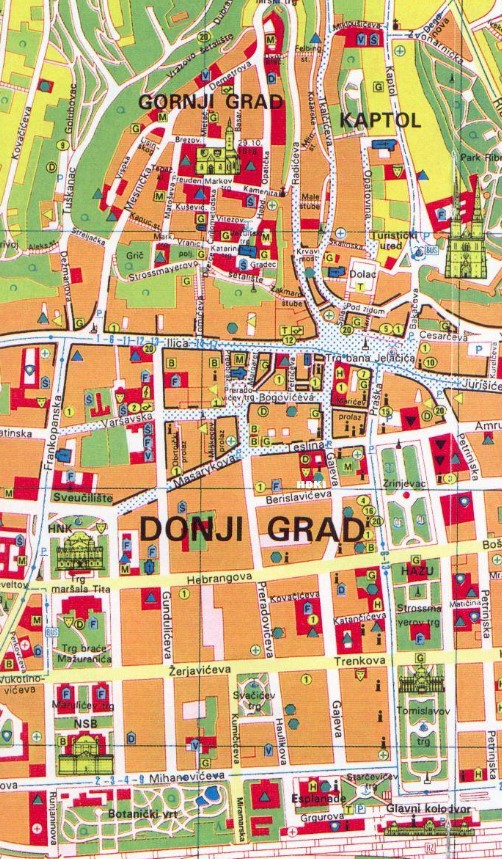
It is flat and is relatively small compared to other European capitals so walking around is not too taxing.
There are lots of parks and even forests within the city limits.
For us simple tourists it is beautifully laid out in a U shape meaning if you go up one major park, across a bit and back down the other park you have pretty much ticked all the big tourist boxes.
The strict town planning scheme outlined that all streets must be straight and of the same width, and all buildings of the same type and height. The town itself is lovely, but it is a terrible state of disrepair. The main tourist walks are ok but stray just a little off the path and the neglect and graffiti become painfully evident. And they have seriously taken their toll on the city. While it is clear that attempts are being made to pull this back (scaffolding and renovations abound) for now the city looks quite derelict.
For us the obvious place to start our tour of the town was at the top end of the U which was the central railway station. An impressive building (but a rubbish train station) , directly opposite is a huge statue of Kralj Tomislav (former prince and believed ruler dating around the 9th century) on a horse and a park leading towards the Art Pavilion.



Crossing the road from the the Art Pavillion you enter the Park Josipa Jurja Strossmayera (a Croatian bishop, theologian, politician, and founder of central Croatian scientific and cultural institutions). The park is another lovely green space making up the straight part of the U but in reality is a park full of old guy statues.




Next on the U is Park Zrinjevac another green space with fountains and a meteorological column at the end that was erected in 1884.


Popping out of here you find yourself in Ban Jelacic Square. This is the main square of Zagreb and is the starting point for exploring the downtown area. The square is huge, with lovely buildings surrounding it on all four sides. The majority of buildings date back to the 19th century and feature different architectural styles: from post-modernism, Art Nouveau, and Biedermeier.
In the square is yet another very impressive statue of a dude on a horse (Count Josip Jelacic – an important Croatian politician of the 19th century). There is a very impressive copper diorama showing the old town area, also a local (Dolac) market and the usual array of retail shops and transport.



Just around the corner is the main church in town (Cathedral of the Assumption of the Blessed virgin Mary) which has been under permanent renovations for decades. In fact there is not one photo of it in its original form (without scaffolding) for many years. I found one on google images but cannot tell how long ago it looked this way. Our photos are what most people get to see.



Across the U and you find yourself at the bottom of the Lotrščak Tower and the the Grič cannon which fires every day exactly at noon, and has done for over 100 years. The tower was part of the southern gate and town defences against the Turks, built in 1266. The Zagreb Funicular is the shortest funicular in the world but also the oldest and first means of public transportation in Zagreb.



Once up the top you find yourself among a bunch of impressive buildings, museums and galleries along with the impressively roofed St. Marc Church.




Finishing off the bottom of the U you come across the Stone gate (Kamenita Vrata), a very cool horse and dragon statue and into the usual retail and tourist offerings that cannot be avoided.





With all of that done all that is left is to walk the straight part of the other side of the U. The first thing you hit is the Hrvatsko narodno kazalište (Croatian National Theatre), a tribute to Marko Marulić ( the 14th century father of Croatian literature). And of course, lots of green space along the way and finally finishing at the botanical garden.




According to the blurb, the key bits of upper town are the tucked away courtyards within the buildings. Twice a year celebrations (Secrets of Grič, and Dvorišta) open the courtyards to reveal their secrets.







Oh and as is our way, we might have taken the opportunity to sample some of the local beers. They do tend to be very tasty and along the Czech lines however, they are much more gassy which left us feeling similarly.








Horse Statues
On doing the research for this and other cities I came across the following blurb about people who are represented in statues on horses. The position of the horse indicates how the figure died in real life. If the horse has one leg raised it is meant to mean that the person died of wounds from the battlefield. If the horse had its both legs raised, the person died in combat. Lastly, if the horse had all four legs on the ground, the person died of natural causes.



Knin

Our journey to Split started with an early morning train from Zagreb. What we did not realise was that we were travelling on the 5th of August, which is a national day of celebration and remembrance. On this day in 1995 the town of Knin was liberated from Serbian forces in a combined military and police operation “Storm”.
In the course of the operation several towns liberated and at exactly noon, a twenty-meter Croatian flag was hoisted at the Knin Fortress. After 84 hours, Knin and additional 11,000 square kilometers of occupied territory were freed. The Croatian Army and Police forces liberated area up to the internationally recognized border between Croatia and Bosnia and Herzegovina.



From 1996 till today this day has been marked as a public holiday that is now called Victory and Homeland Thanksgiving Day and the Day of Croatian Defenders.
And we were belting past and briefly stopping on the train. The first sign was a bunch of military uniforms and checkpoints. The next was monster tanks and rocket launchers. A look up the hill showed the fortress and what appeared to be quite a lot of commotion, which at the time we were oblivious to.
Split
We arrived in split mid afternoon and immediately descended into a nightmare. The train station, bus station and tourist docks were all in one very tiny spot of land and there were bodies and vehicles going in every direction. It was bedlam.
Thankfully our hotel was only about half a kilometre away (up the hill) and was near Bacvice Beach (the main tourist beach in town). As it was the national holiday, most of what was available was closed.
Split is the second-largest city of Croatia after the capital Zagreb, the largest city in the region of Dalmatia and the largest city on the Croatian coast. It lies on the eastern shore of the Adriatic Sea and is spread over a central peninsula.
The most important thing to know is that there are three Splits.
The first is Land Split – which is full of old buildings, castles and palaces along with Game of Thrones (GoT) filming locations.


The second Split is Water Split which takes in stunning water locations such as the blue cave, blue lagoon, shipwrecks.
Unfortunately this also runs into the third Split, Party Split.
A ton of 18-20 somethings are being fed unlimited fixed price drink packages in a sunny and decadent location. This is a recipe for disaster. I’m sure in my 20’s I would have loved it.
Sadly, third Split necessitates the printing and signposting of this photo.
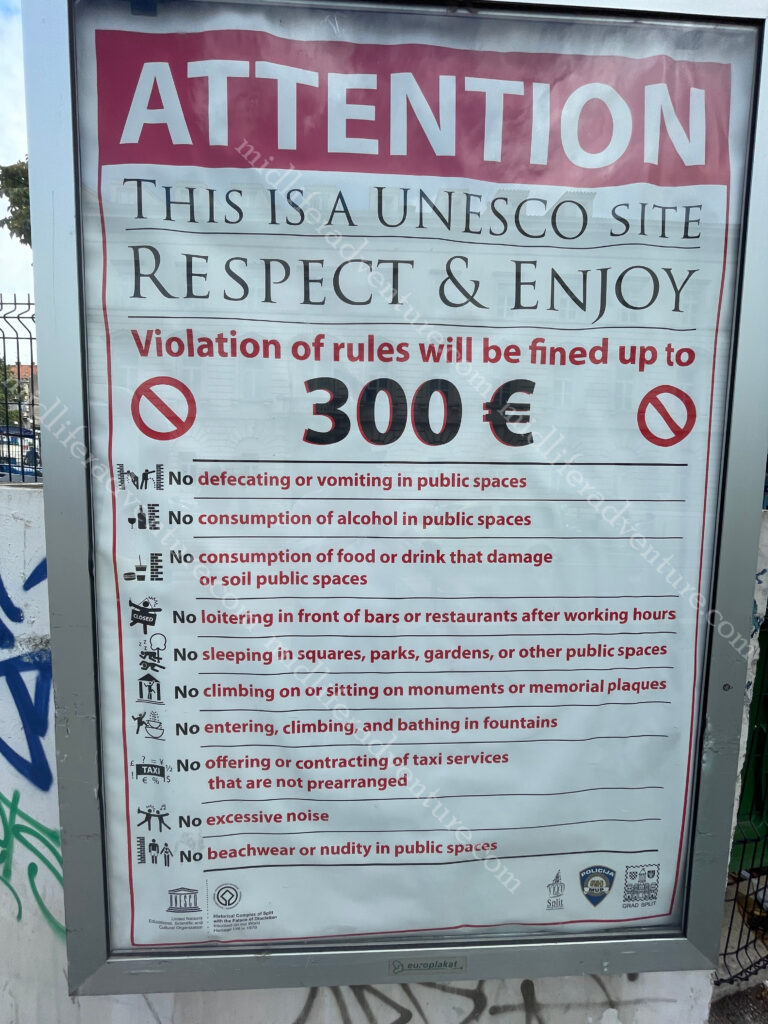




The main show in town is the Diocletian’s Palace. The ruins of the Roman Emperor Diocletian’s palace date back to the late 3rd to early 4th century A.D. This isn’t just a palace or a ruin, rather it has been consumed by and now constitutes the entire old town centre. The ancient walls, gates and columns ring the palace but over the period (1700 years or so) the Renaissance houses, palaces, cobbled streets and squares all grew within the space that was once the palace.









The Cathedral of Saint Domnius was built in the 4th century and is known locally as the Sveti Dujam. Strictly the church is dedicated to the Virgin Mary, and the bell tower to Saint Domnius. Together they form the Cathedral of St. Domnius. It was consecrated at the turn of the 7th century AD, is regarded as the oldest Catholic cathedral in the world that remains in use in its original structure. The structure itself was built in AD 3.



In the Palace is a Game of Thrones Museum that allows fans to step inside Meereen and the GoT more broadly. The museum has some original artifacts, props, costumes, actual size figures, weapons, city dioramas, sets and more.






Froggyland – well, let’s just let the pictures speak for themselves.






About 14 kilometres out of town you can find the Klis Fortress perched in the mountain pass between Mosor and Kozjak. Getting here was a simple 20 minute bus ride on the local transport for the princely sum of three euros.
The fortress has a history going back more than 2000 years, beginning with the Illyrian tribe called Dalmatae that used it as a stronghold before it was taken by the Romans. After the fall of the Roman Empire, the site became a seat for several Croatian kings. And of course, the fortress was used as a GoT film set.












Jill even found herself in her own drama with an overly entitled Instagrammer. We were appalled to hear this whiny nasal voice telling everybody to move as she was trying to take a “real photo”.
As soon as the path cleared a bit another person would step into the shot (it is a pretty popular place) causing another round of whining. I made sure to step in and get my photos and Jill stepped in a short while later to get hers, ensuring to take her time. When the girl tried to pull Jill on, she responded that we had all paid the same amount of money and were all able to get our photographs and that she was not going to pander to her sense of entitlement.
This was met by giggles from those around and prompted a steadily annoying stream of people standing exactly where she was trying to clear. The worst thing about all of this, the whiny, nasal voice was accompanied by an overtly Australian accent. I am hoping that this is not the future touring reputation that Australians will get.
Back to town to see the remainder of the Palace and old town and then back to our accommodation to prepare for the next leg through to Dubrovnik.








The next day we had hours to kill while we waited for the bus trip that we had been dreading for a while now. The further east you go in Europe, the shittier things get. The organisation and schedule of Germany falls by the wayside and is replaced with increasingly half-assed versions. The trains go from fast, comfortable transports through to old diesel clunkers. And eventually the trains disappear all together and bus transfers are all that is left.
This was the first of the bus transfers. And our dread manifested immediately at the chaos that was the bus station. There were about a thousand (literally) people with luggage waiting and no board available to figure out where/when (if at all) your bus may turn up. Busses turned up and left with little or no explanation and the poor drivers were besieged by confused (and annoyingly needy) tourists.





Ok first things first, the Croatian coastline is stunning. After the debacle that was the bus station, the rest of the trip was perfectly satisfactory. There were some overly chatty (chain-smoking) bus drivers that answered every question (from each other) 4 -5 times. So the bus was filled with second hand smoke and the sounds of da da da da da or ya ya ya ya ya ya. But otherwise, the trip was great and the scenery was incredible.
Dubrovnik
Dubrovnik is basically the most famous Game of Thrones (GoT) filming destination on the planet. It was the filming location for the city of Westeros, Kings Landing. Within the walls of Old Town there were many GoT scenes shot. And today you can barely walk the streets without crashing into a GoT tour, shop, memorabilia outlet or sign highlighting how it related to the show. Suffice to say, that almost everything you see or that I will mention in the following is related in some way shape or form to the show.





Our accommodation (thankfully) was out of the craziness that is the old town. We were down on the water, a few kilometers away near the port. The setting was stunning and at least (while we did not know it at the time) we were away from the insanity. We arrived after 8pm and headed out for a lovely meal by the water, vowing to brave the tourist sights the next morning.
Our first introduction to what was to follow was the slow walk that we decided to take to Old Town (rather than catch the local bus). And this introduction was boat load after boat load of party boats stocking up on their quota of tourists for the day trips. The waterfront was packed with boats, each jamming 50+ people per boat and the bigger ones doing way more. And of course there is the daily cruise ships



Dubrovnik Old Town is known as one of the world’s finest and most perfectly preserved medieval cities in the world. For centuries it rivalled Venice as a major trading port. It was built between the 11th and 17th centuries, affording protection to the main entry gate.
The main attractions within old town include the city walls (which you can walk around (for 35 euros a head) this will include towers, walls and defences. Inside the city proper are the clock and bell tower, churches (Sveti Vlaho, Saint Saviour and the Cathedral), monasteries (Dominican and Franciscan), squares (Stradun, Placa, Lužaand and Gunduliceva), and the GoT favourite the Jesuit Stairs.





Having navigated past the harbour we kept walking towards the old town figuring we would see some cool stuff along the way. The first sight we came across was the Lovrijenac Fortress. This is a 16th Century Fortress with 12 metre thick Fortress walls. Over the centuries the fortress played a pivotal role in the defence of Dubrovnik.



This and the Bokar Fortress (opposite side of the inlet) create a fairly imposing landing point for any old-time invading force. Bokar Fortress was built in the 15th century to defend the town’s main entrance. It is the round lump that hangs off the end of old town just to the side of the main entry gate. Currently, in its interior, there are several cannons on display as well as a small precious stones (lapidary) collection.




Pile Gate is the main entrance to Dubrovnik City, and is one of only two entrances to the city. We were here relatively early in the morning and it was already seriously busy, with bodies all over the place and hellish tour groups taking up all the available space.


As you pass through the Pile Gate you are met with two imposing buildings and a fountain. To the left if the Franciscan Monastery and to the right is the St Claire Convent with the Onofrio’s fountain directly in front. The other thing you are met with is a wall of humanity. Everyone gets through the gates and stops to take pictures. As we were here early it was fairly manageable but by the time we were ready to leave this place was a debacle.




Between the two runs the Stradun (main street) which connects the western and eastern entrances to the city. It was created at the end of the 9th century and was rebuilt after an earthquake in 1667. At the beginning and end of Stradun, there are two fountains (Big and Small Onofrio’s Fountain) and two bell towers (City bell tower and the bell tower of the Franciscan church and monastery).


Minceta Tower is the highest point in Dubrovnik City and as you would expect, delivers impressive views over the sea and the Old Town.
Locally known as Tvrđava Minčeta, the tower was built in 1319.
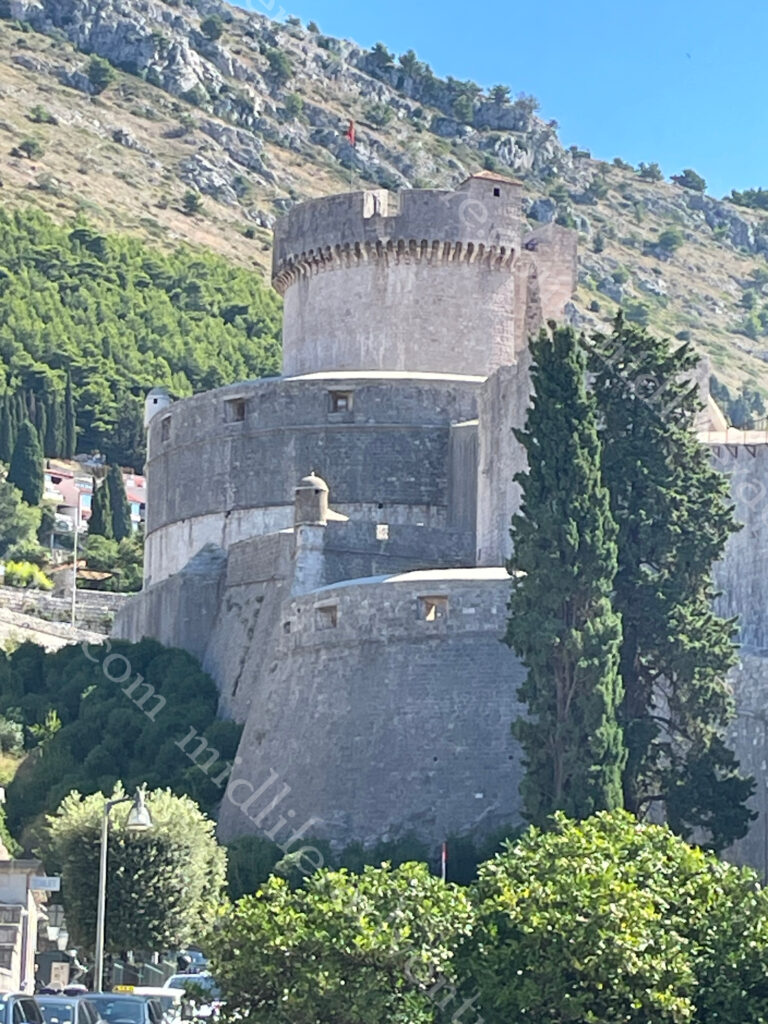
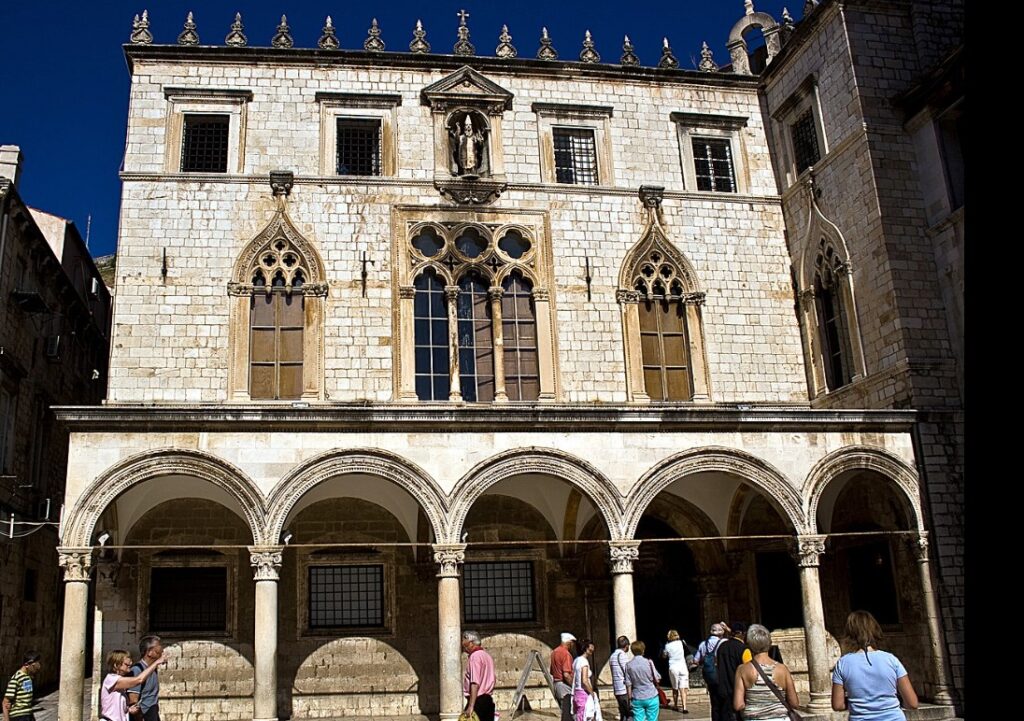
Palace Sponza was built in the 16th century and has been used as the customs house, armoury, treasury, bank and school.
The Rector’s Palace or Knežev dvor used to serve as the seat of the Rector between the 14th century and 1808. Originally it was a site of a defence building in the early Middle Ages. It was destroyed by a fire in 1435 and the city-state decided to build a new palace.
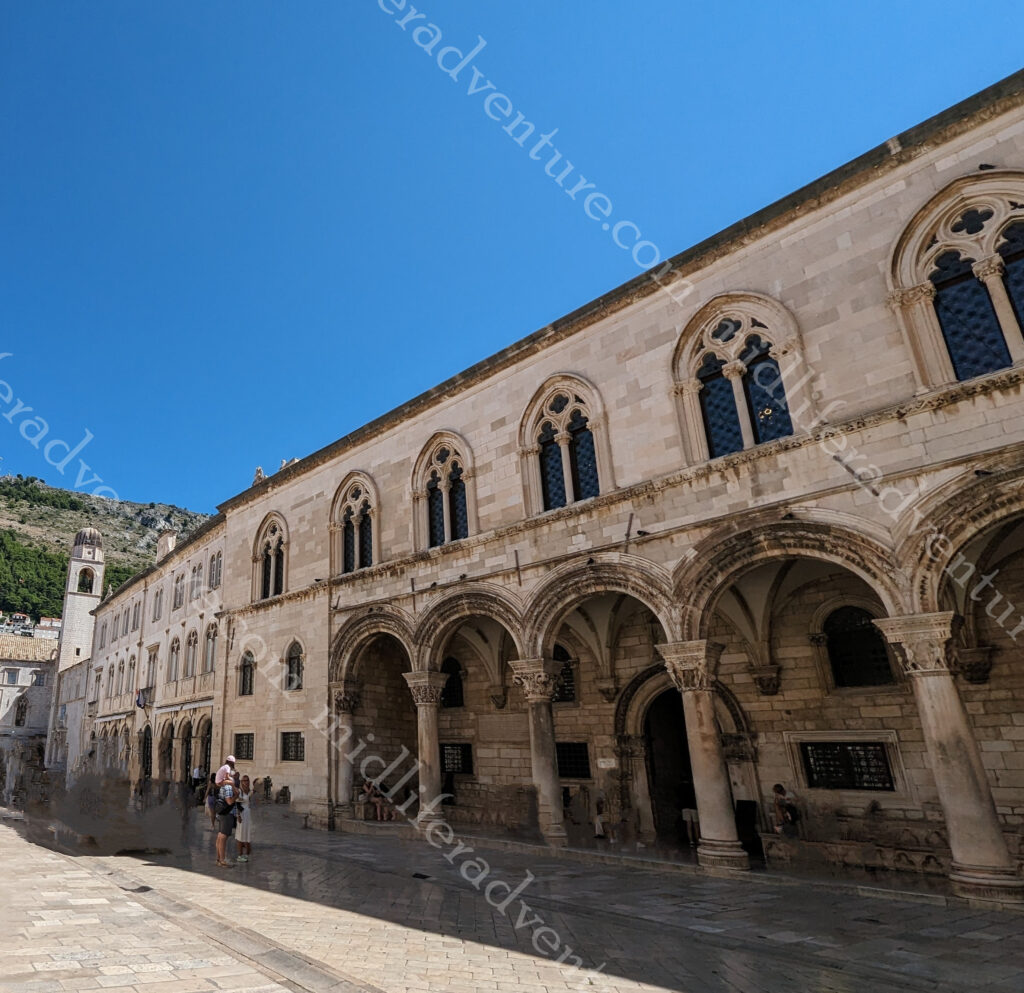
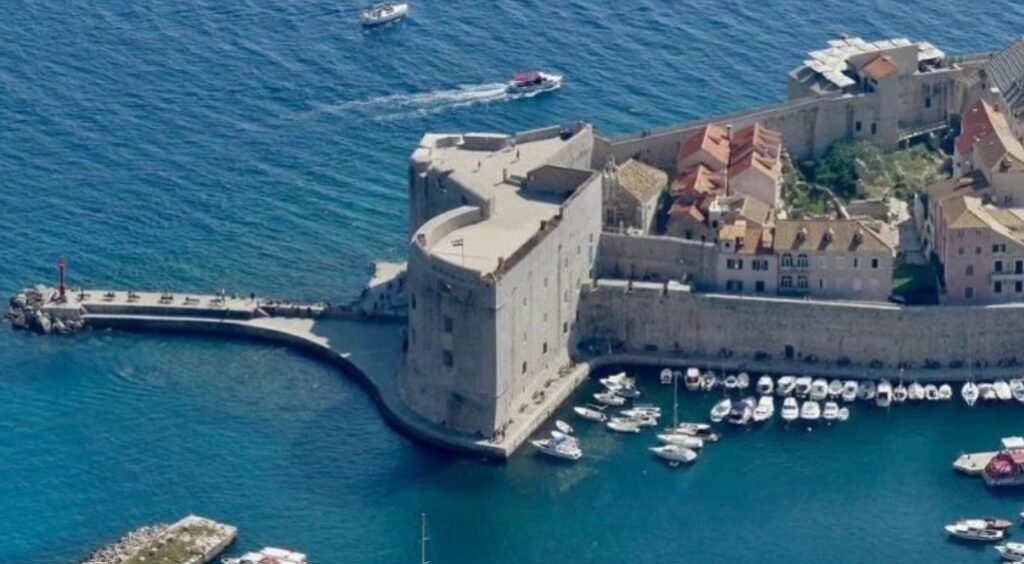
Sveti Ivan tower was built in the 14th century on the south side of old town. On its ground floor there is an aquarium, and on the 1st and 2nd floor there is a Maritime Museum.
Lokrum Island is located just off the Dubrovnik coast. According to legend Richard the Lion-Heart was cast ashore here after being shipwrecked in 1192 while returning from the Crusades. The vow he made to build a church on the spot where he came ashore should he be saved was kept at least in part. Although he came ashore in Lokrum, at the request of the people of Dubrovnik, he agreed to have the church built in the city itself.
At its center is a medieval Benedictine monastery complex that’s surrounded by botanical gardens planted with exotic trees, flowers, and bushes. Inside the Visitors Centre on Lokrum Island is a small exhibition dedicated to GoT and it is the final resting place of the original Iron Throne.







Located near Gundulic Square in the centre of Dubrovnik Old Town the Jesuit Staircase and St Dominika Street are the two most popular areas in the whole of old town. This is the area where one of the most famous GoT scenes were filmed (Cersei’s infamous walk of shame).




We were totally over the crowds and the people and were on our way out of old town by 11am. On our way out the bedlam that we saw on the way in was multiplied by about 5 times. The lines were longer, the crowds were denser and the tempers were shorter.
Dubrovnik is an absolutely lovely city to visit. Just don’t do it in peak season. July and August are hellish and should be avoided at all costs. Don’t get me wrong, you really want to come here, but the peak-season crowds make this place unbearable.